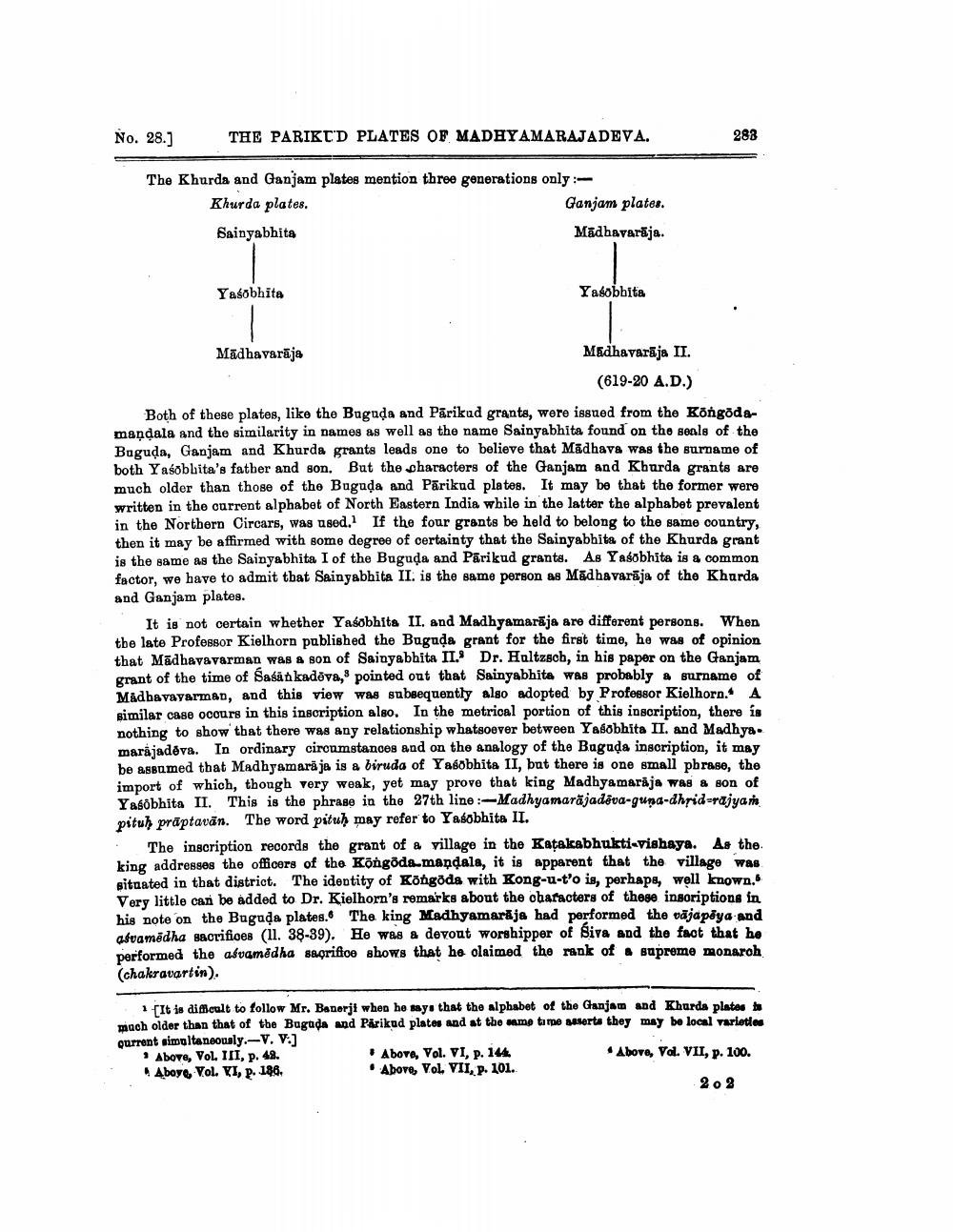________________
No. 28.]
THE PARIKI'D PLATES OF MADHYAMARAJADEVA.
288
The Khurda and Ganjam plates mention three generations only:Khurda plates.
Ganjam plates. Sainyabhita
Mādhavarēja.
Yasobhita
Yasobbita
Madhavarāja
Madhavarāja II.
(619-20 A.D.)
Both of these plates, like the Baguda and Pārikud grants, were issued from the Kongodamandala and the similarity in names as well as the name Sainyabhita found on the seals of the Baguda, Ganjam and Khurds grants leads one to believe that Midhava was the sumame of both Yasobhita's father and son. But the characters of the Ganjam and Khurda grants are much older than those of the Buguda and Pārikud plates. It may be that the former were written in the current alphabet of North Eastern India while in the latter the alphabet prevalent in the Northern Circars, was used. If the four grants be held to belong to the same country, then it may be affirmed with some degree of certainty that the Sainyabhita of the Khurda grant is the same as the Sainyabhita I of the Buguda and Pārikud grants. As Yasobhita is a common factor, we have to admit that Sainyabhita II. is the same person as Madhavarija of the Kharda and Ganjam plates.
It is not certain whether Yasobhita II. and Madhyamarāja are different persons. When the late Professor Kielhorn published the Buguda grant for the first time, he was of opinion that Madhavavarman was a son of Sainyabbita II. Dr. Holtzsch, in his paper on the Ganjam grant of the time of Saśän kadova, pointed out that Sainyabhita was probably a surname of Mädbavayarman, and this view was subsequently also adopted by Professor Kielhorn. A similar case ocours in this inscription also. In the metrical portion of this inscription, there is nothing to show that there was any relationship whatsoever between Yasobhita II. and Madhya. marajadēva. In ordinary cironmstances and on the analogy of the Bagada inscription, it may be assumed that Madhyamarája is a biruda of Yabobhita II, but there is one small pbrase, the import of which, though very weak, yet may prove that king Madhyamaraja wag & son of Yasobhita II. This is the phrase in the 27th line :-Madhyamarājadova-guna-dhrid-rajyan pituh praptavān. The word pituh may refer to Yasobhita II.
The inscription records the grant of a village in the Katakabhukti vishaya. As the king addresses the officers of the Köngöda.mandala, it is apparent that the village was situated in that district. The identity of Köngöds with Kong-u-t'o is, perhaps, well known. Very little can be added to Dr. Kielhorn's remarks about the characters of these insoriptions in his note on the Bugada plates. The king Madhyamarája had performed the väjapoya and afvamëdha sacrifices (11. 38-39). He was a devout worshipper of Siva and the fact that he performed the afvamëdha sacrifice shows that he olaimed the rank of supreme monarch (chakravartin).
1 fit is difficult to follow Mr. Banerji when he says that the alphabet of the Ganjam and Khurda plates to much older than that of the Bugada and Pärikud plates and at the same time beserta they may be local varieties current simultaneously.-V. V.) Above, VOL. III, p. 48. Above, Vol. VI, p. 144.
. Above, Vd. VII, p. 100. Aboy, Vol. VI, p. 186. . Above, Vol. VII, p. 101.
202




